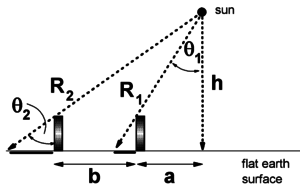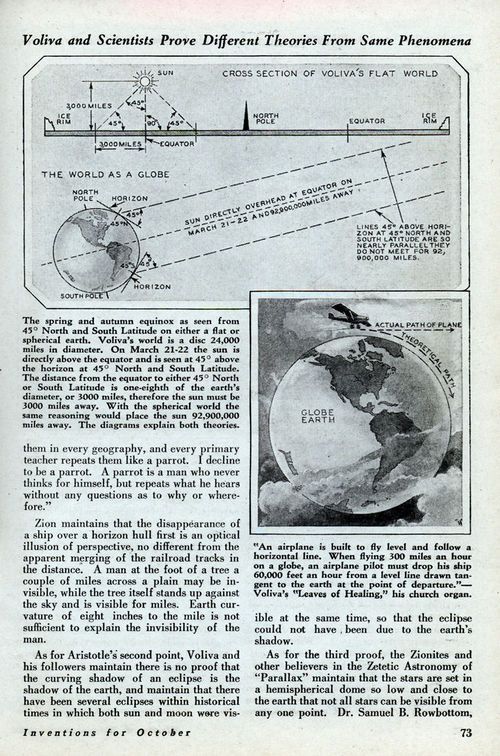Distance to the Sun
Disclaimer
The distance to the sun and the celestial bodies has been in some contention over the years. In Chapter 5 of Earth Not a Globe Samuel Birley Rowbotham computes the sun to be less than 700 miles above surface of the earth, and the stars contained within 1000 miles. Later researchers have estimated the sun to be at about 3000 miles above the surface of the earth, with the stars at about 100 miles above that. However, the exact methodology of that later research in regards to how the angles were determined has been lost over time. It is apparent that there may be some assumptions in the 3000 mile figure, in regards to the angle of the sun or the distance between the two points used.
The purpose of this page is to showcase the basic methods that have been used.
Distance to the Sun
Q. Why are the celestial bodies and the sun so close to the earth's surface in the Flat Earth Model?
A. The celestial bodies must be close because if the shape of the earth changes, the distance to the celestial bodies must change as well. Astronomers use two different observations on far off points on earth to triangulate the distance of celestial bodies. When the shape of the earth changes, the triangulation changes, and our perception of the universe must therefore change as well.
Eratosthenes' stick experiment can not only tell us about the size of the earth, but can also be used to compute the distance to the sun as well. If the earth is round, the celestial bodies are computed to be millions of miles distant. If the earth is flat, the celestial bodies are triangulated to be relatively close to the earth's surface.
In his experiment Eratosthenes assumes that the earth is a globe and that the sun is very far away in his computations for the size of the earth and the distance to the sun. However, if we use his data with the assumption that the earth is flat we can come up with a wildly different calculation for the distance of the sun, showing it to be close to the earth. The sun changes its distance depending on the model of the earth we assume for the experiment.
Millersville University goes over the two ways of interpreting Eratosthenes' data. The first part of the article goes over the interpretation of his data under a Round Earth model, and the bottom part of the article goes over an interpretation of the data under a Flat Earth model.
Here's a link which explains the idea: http://www.millersville.edu/physics/experiments/058/index.php. The first part goes over the Round Earth explanation for how the sun can be computed millions of miles distant. At the bottom there is a Flat Earth explanation for how the sun can be computed as being very close to the earth's surface. Scroll all the way to the bottom to the "alternative model" section. You will find that we can use Eratosthenes' data, in conjunction with the assumption of a Flat Earth, to confirm that in FET the sun is very near to the earth's surface.
Hence, if we assume that the earth is flat, triangles and trigonometry can demonstrate that the celestial bodies are fairly close to the earth.
Eratosthenes' model depends on the assumption that the earth is a globe and
that the sun is far away and therefore produces parallel rays of light all
over the earth. If the sun is nearby, then shadows will change length even
for a flat earth. A flat earth model is sketched below. The vertical stick
casts shadows that grow longer as the stick moves to the left, away from the
closest point to the sun. (The sun is at height h above the earth.)
 A little trigonometry shows that
A little trigonometry shows that
 Using the values 50 degrees and 60 degrees as measured on the trip, with
b=1000 miles, we find that h is approximately 2000 miles. This relatively close
sun would have been quite plausible to the ancients.
Continuing the calculation, we find that a is approximately 2400 miles and the two
distances R1 and R2 are approximately 3000 and 3900 miles, respectively.
Using the values 50 degrees and 60 degrees as measured on the trip, with
b=1000 miles, we find that h is approximately 2000 miles. This relatively close
sun would have been quite plausible to the ancients.
Continuing the calculation, we find that a is approximately 2400 miles and the two
distances R1 and R2 are approximately 3000 and 3900 miles, respectively.
There is no other way to get a distance for the sun. Just looking at it from a single point on earth will not tell you its distance, you must look at it from several points and account for the curvature or non-curvature of the distance between those points.
Please note: The writer of that article makes a unrelated side comment about the Flat Earth model --
That is, as we move from Florida to Pennsylvania, our distance from the sun
increases by about 30%. As a consequence the apparant size of the sun should
decrease by 30%. We see no noticeable change in the apparent size of the sun as
we make the trip. We conclude that the flat earth/near sun model does not work.
This has nothing to do with Erasthone's calculations for the sun's distance and the writer apparently did not read Chapter 10 of Earth Not a Globe. See: Magnification of the Sun at Sunset
Sun's Distance - Zetetic Cosmogony
Thomas Winship, author of Zetetic Cosmogony, provides a calculation demonstrating that the sun can be computed to be relatively close to the earth's surface if one assumes that the earth is flat --
On March 21-22 the sun is directly overhead at the equator and appears
45 degrees above the horizon at 45 degrees north and south latitude. As
the angle of sun above the earth at the equator is 90 degrees while it is
45 degrees at 45 degrees north or south latitude, it follows that the angle
at the sun between the vertical from the horizon and the line from the
observers at 45 degrees north and south must also be 45 degrees. The result
is two right angled triangles with legs of equal length. The distance between
the equator and the points at 45 degrees north or south is approximately 3,000
miles. Ergo, the sun would be an equal distance above the equator.
Sun's Distance - Modern Mechanics
Modern Mechanics describes how on a Flat Earth the sun can be computed to 3,000 miles via triangulation, whereas on a globe earth those same angles can calculate the sun to nearly 93 million miles away --
$5,000 for Proving the Earth is a Globe (Modern Mechanics - Oct, 1931)

